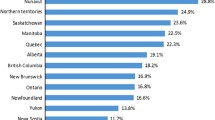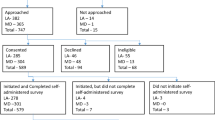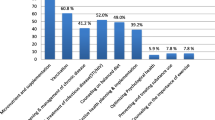Abstract
Ethnic minorities living in the US have lower utilization and access to prenatal care, resulting in an increased risk of adverse pregnancy outcomes. The present study examines utilization of prenatal care, perceived pregnancy related health, and perceived risk of adverse pregnancy outcomes among Arab women living in the USA cross-sectional study was conducted, consisting of a convenience sample of 170 Arab women. A structured questionnaire was administered by a face-to-face or telephone interview. Multivariable logistic regression was used to calculate adjusted Odds Ratios and 95% Confidence Intervals, controlling for potential confounders. All study participants had received prenatal care during their most recent pregnancy, and 90% had their first prenatal care visit before the 12th gestational week. The Arab women who were older (P = 0.02), those with 12 years of education or less (P = 0.002), and those who had lived in the US more than five years (P = 0.0002) were more likely to report four or more pregnancies. In addition, more than one-third of the women reported having experienced a miscarriage (35.4%), which was significantly associated with gravida status (P < 0.001). An association between perceived susceptibility for spontaneous abortion and stillbirth was also demonstrated (P < 0.0001). Although Arab women reported good coverage of prenatal care, they perceived themselves as susceptible for several pregnancy complications and adverse pregnancy outcomes. Clinical guidelines for prenatal care to Arab women should therefore focus on their high parity and likelihood of miscarriages, in an attempt to reduce their risk of adverse pregnancy outcomes.
Similar content being viewed by others
References
Malin M, Gissler M. Maternal care and birth outcomes among ethnic minority women in Finland. MC Public Health. 2009;9:84.
Lalchandani S, MacQuillan K, Sheil O. Obstetric profiles and pregnancy outcomes of immigrant women with refugee status. Ir Med J. 2001;94(3):79–80.
Essen B, Johnsdotter S, Hovelius B, et al. Qualitative study of pregnancy and childbirth experiences in Somalian women resident in Sweden. BJOG. 2000;107(12):1507–12.
Blais R, Maiga A. Do ethnic groups use health services like the majority of the population? A study from Quebec. Can Soc Sci Med. 1999;48(9):1237–45.
Bona G, Zaffaroni M, Cataldo F, Sandri F, Salvioli GP. Infants of immigrant parents in Italy. A national multicentre case control study. Panminerva Med. 2001;43(3):155–9.
Vangen S, Stoltenberg C, Stray-Pedersen B. Complaints and complications in pregnancy: a study of ethnic Norwegian and ethnic Pakistani women in Oslo. Ethn Health. 1999;4(1–2):19–28.
Merten S, Wyss C, Ackermann-Liebrich U. Caesarean sections and breastfeeding initiation among migrants in Switzerland. Int J Public Health. 2007;52(4):210–22.
Vangen S, Stoltenberg C, Skjaerven R, Magnus P, Harris JR, Stray-Pedersen B. The heavier the better? Birthweight and perinatal mortality in different ethnic groups. Int J Epidemiol. 2002;31(3):654–60.
De la Cruz GP, Powers K. The Arab population: 2000. C2KBR-23. US Census Bureau; http://www.census.gov/prod/2003pubs/c2kbr-23.pdf. Accessed Dec 1, 2010.
El-Sayed AM, Galea S. The health of Arab-Americans living in the United States: a systematic review of the literature. BMC Public Health. 2009;9:272.
Abdulrahim S, Baker W. Differences in self-rated health by immigrant status and language preference among Arab Americans in the Detroit metropolitan area. Soc Sci Med. 2009;68(12):2097–103.
Acevedo-Garcia D, Bates LM, Osypuk TL, McArdle N. The effect of immigrant generation and duration on self-rated health among US adults 2003–2007. Soc Sci Med. 2010;71(6):1161–72.
Laffrey SC, Meleis AI, Lipson JG, Solomon M, Omidian PA. Assessing Arab-American health care needs. Soc Sci Med. 1989;29(7):877–83.
Forna F, Jamieson DJ, Sanders D, Lindsay MK. Pregnancy outcomes in foreign-born and US-born women. Int J Gynaecol Obstet. 2003;83(3):257–65.
El-Sayed AM, Galea S. Explaining the low risk of preterm birth among Arab Americans in the United States: an analysis of 617451 births. Pediatrics. 2009;123(3):e438–45.
El Reda DK, Grigorescu V, Posner SF, Davis-Harrier A. Lower rates of preterm birth in women of Arab ancestry: an epidemiologic paradox–Michigan, 1993–2002. Matern Child Health J. 2007;11(6):622–7.
Lauderdale DS. Birth outcomes for Arabic-named women in California before and after September 11. Demography. 2006;43(1):185–201.
El-Sayed A, Hadley C, Galea S. Birth outcomes among Arab Americans in Michigan before and after the terrorist attacks of September 11, 2001. Ethn Dis. 2008;18(3):348–56.
Awwad R, Veach PM, Bartels DM, LeRoy BS. Culture and acculturation influences on Palestinian perceptions of prenatal genetic counseling. J Genet Couns. 2008;17(1):101–16.
Funk S, Gilad E, Watkins C, Jansen VA. The spread of awareness and its impact on epidemic outbreaks. Proc Natl Acad Sci USA. 2009;106(16):6872–7.
Healy AJ, Malone FD, Sullivan LM, et al. Early access to prenatal care: implications for racial disparity in perinatal mortality. Obstet Gynecol. 2006;107(3):625–31.
Sherraden MS, Barrera RE. Prenatal care experiences and birth weight among Mexican immigrant women. J Med Syst. 1996;20(5):329–50.
Twizer I, Sheiner E, Hallak M, Mazor M, Katz M, Shoham-Vardi I. Lack of prenatal care in a traditional society. Is it an obstetric hazard? J Reprod Med. 2001;46(7):662–8.
Jaber L, Dolfin T, Shohat T, Halpern GJ, Reish O, Fejgin M. Prenatal diagnosis for detecting congenital malformations: acceptance among Israeli Arab women. Isr Med Assoc J. 2000;2(5):346–50.
Al-Gazali L, Hamamy H, Al-Arrayad S. Genetic disorders in the Arab world. BMJ. 2006;333(7573):831–4.
Hammad A, Kysia R, Rabah R, Hassoun R, Connelly M. Guide to Arab culture: health care delivery to the Arab American community. Dearborn: Arab Community Center for Economic and Social Services; 1999.
Amer MM, Hovey JD. Socio-demographic differences in acculturation and mental health for a sample of 2nd generation/early immigrant Arab Americans. J Immigr Minor Health. 2007;9(4):335–47.
Read JG, Amick B, Donato KM. Arab immigrants: a new case for ethnicity and health? Soc Sci Med. 2005;61(1):77–82.
Bond S. US infant mortality rate lags significantly behind other developed nations: higher preterm birth rates, changing labor management practices mostly likely to blame. J Midwifery Womens Health. 2010;55(3):287–8.
Ghazal-Aswad S, Rizk DE, Al-Khoori SM, Shaheen H, Thomas L. Knowledge and practice of contraception in United Arab Emirates women. J Fam Plann Reprod Health Care. 2001;27(4):212–6.
Mahgoub YM. Socio-economic and demographic factors affecting contraceptive use in Egypt. Egypt Popul Fam Plann Rev. 1994;28(2):104–15.
Abdulrazzaq YM, Bener A, al-Gazali LI, al-Khayat AI, Micallef R, Gaber T. A study of possible deleterious effects of consanguinity. Clin Genet. 1997;51(3):167–73.
Severinski NS, Mamula O, Severinski S, Mamula M. Maternal and fetal outcomes in grand multiparous women. Int J Gynaecol Obstet. 2009;107(1):63–4.
Babinszki A, Kerenyi T, Torok O, Grazi V, Lapinski RH, Berkowitz RL. Perinatal outcome in grand and great-grand multiparity: effects of parity on obstetric risk factors. Am J Obstet Gynecol. 1999;181(3):669–74.
Al-sibai MH, Rahman MS, Rahman J. Obstetric problems in the grand multipara: a clinical study of 1330 cases. J Obstet Gynaecol (Lahore). 1987;8(2):135–8.
Humphrey MD. Is grand multiparity an independent predictor of pregnancy risk? A retrospective observational study. Med J Aust. 2003;179(6):294–6.
Juntunen K, Kirkinen P, Kauppila A. The clinical outcome in pregnancies of grand multiparous women. Acta Obstet Gynecol Scand. 1997;76(8):755–9.
Fuchs K, Peretz BA, Marcovici R, Paldi E, Timor-Tritsh I. The “grand multipara”—is it a problem? A review of 5785 cases. Int J Gynaecol Obstet. 1985;23(4):321–6.
Haider G, Zehra N, Munir AA, Haider A. Risk factors of urinary tract infection in pregnancy. J Pak Med Assoc. 2010;60(3):213–6.
Sheikh MA, Khan MS, Khatoon A, Arain GM. Incidence of urinary tract infection during pregnancy. East Mediterr Health J. 2000;6(2–3):265–71.
Fatima N, Ishrat S. Frequency and risk factors of asymptomatic bacteriuria during pregnancy. J Coll Phys Surg Pak. 2006;16(4):273–5.
Atiullah N, Fikree FF, Husain I. An epidemiologic study of cystitis among Muslim women attending an out-patients clinic in Karachi. J Pak Med Assoc. 1998;48(2):35–7.
Hathout H, Kasrawi R, Moussa MA, Saleh AK. Influence of pregnancy outcome on subsequent pregnancy. Int J Gynaecol Obstet. 1982;20(2):145–7.
Thom DH, Nelson LM, Vaughan TL. Spontaneous abortion and subsequent adverse birth outcomes. Am J Obstet Gynecol. 1992;166(1 Pt 1):111–6.
Elam-Evans LD, Straus LT, Herndon J, Parker WY, Bowens SV, Zane S et al. Abortion Surveillance—United States, 2000. November 28, 2003/52(SS12);1–32; http://www.cdc.gov/mmwr/preview/mmwrhtml/ss5212a1.htm. Accessed Aug 10, 2010.
Luo ZC, Wilkins R, Kramer MS. Effect of neighbourhood income and maternal education on birth outcomes: a population-based study. CMAJ. 2006;174(10):1415–20.
Salganik MJ, Heckathorn DD. Sampling and estimation in hidden populations using respondent-driven sampling. Sociol Methodol. 2004;34:193–239.
Jamal A, Naber NC. Arab Americans: from invisible citizens to visible subjects. Syracuse: Syracuse University Press; 2008.
Author information
Authors and Affiliations
Corresponding author
Rights and permissions
About this article
Cite this article
Ma, P., Magnus, M.C. & Magnus, J.H. Perception of Pregnancy Related Health Issues Among Arab Women Living in the United States. J Immigrant Minority Health 15, 273–280 (2013). https://doi.org/10.1007/s10903-012-9589-3
Published:
Issue Date:
DOI: https://doi.org/10.1007/s10903-012-9589-3




